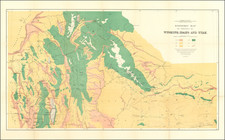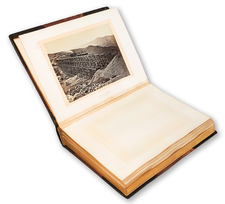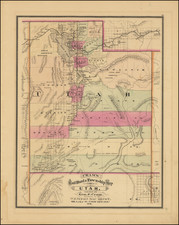Mammoth Mountain, Utah -- Promoting Mining Investments in The Tintic Mining District
Interesting pair of panoramic views of a mining area near Mammoth, Utah, likely printed in about 1892.
The map illustrates Mammoth (possibly Mammoth Utah), the Copperopolis Group, Phoenix (mine), Opehonga, Silver Spar Group, Red Rose and North Star Group.
The map identifies George Ryan as the owner of "the Company." promoting this mining project, which involved the Argenta, Silver Star, Silver Spar, Lisbon, Leo, Base and Oro Lodes.
The Tintic Mining District
The district's narrative began in the 1860s when U.S. Army soldiers stationed at Camp Floyd stumbled upon ore in the West Tintic Mountains. However, the true genesis of the district is attributed to the discovery of silver by prospectors in 1869. This discovery sparked a flurry of activity that led to the founding of numerous settlements, including Eureka, Silver City, Mammoth, and Diamond. The region was named after the Tintic tribe of Native Americans who previously inhabited the area.
The Tintic District is about six miles long by two miles wide on the border of Utah and Juab counties. The district mined for gold, silver, copper, and other minerals. It was heavily active from 1869 to 1917.
The 1870s and 1880s marked the district's golden era. Mines like the Sunbeam, Eureka Hill, Gemini, and Bullion Beck and Champion were established, yielding rich deposits of silver, gold, copper, lead, and bauxite. The burgeoning industry attracted a surge of workers and their families, swelling the district's population and transforming it into a bustling hub of economic activity.
The district's decline began in the early 20th century. The depletion of high-grade ores, the fall in silver prices due to the Silver Panic of 1893, and the economic pressures of the Great Depression took a heavy toll on mining operations. Many of the mines closed, and communities shrank. By the mid-20th century, large-scale mining had largely ceased, though some small-scale operations continued.












![[ Early Western Automobile Road Map ] Goodrich Road Map of Arizona - Colorado - New Mexico - Utah](https://storage.googleapis.com/raremaps/img/small/101927.jpg)
![California [with large inset of Utah and Part of New Mexico]](https://storage.googleapis.com/raremaps/img/small/92004.jpg)


![[Large panoramic view of Salt Lake City] La Nouvelle Jerusalem, ou La Grande Ville du Lac Sale (Amerique).](https://storage.googleapis.com/raremaps/img/small/77721.jpg)